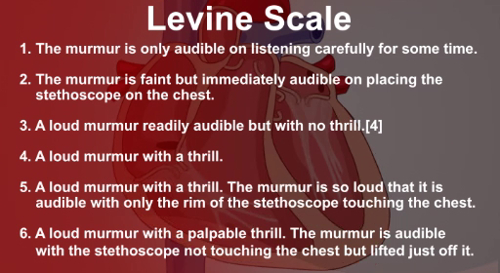心臓試験 III: 異常な心臓の音
概要
ソース: Suneel Dhand、MD、医師、内科、ベス イスラエス ディーコネス メディカル センターに参加
正常な心臓の音の基本的な理解を持っていることは、異常と正常を区別するための第一歩です。雑音は、心臓弁の間で乱流と異常な血流を表す音です。彼らは (弁エリア狭すぎる) 狭窄や逆流 (弁血液の逆流) によって引き起こされます、聴診時によく「ヒューヒュー」音として聞いています。雑音は強度 (1 柔らかいと 6 を最も騒々しいされている) (図 1) の 6 に 1 から評定されます。聞いた最も一般的な心臓の雑音は、大動脈弁と僧帽弁の弁のささやきを左サイドです。肺と三尖弁のささやきを右サイド、あまり一般的です。雑音は、弁の病理学と対応する解剖学的領域でいちばん声をはりあげて聞いている通常。頻繁に、彼らはまた他の区域に放射します。

図 1。グレード雑音強度に使われる Levine スケール。
2 つの主要な心臓の音に加えて S1 と S2 の閉鎖によって普通作り出される心臓弁、S3 および S4 として知られている他の 2 つの異常な心臓音があります。これらは、行の 2 つ以上の音の「ギャロッピング」性質のため競馬で、として知られています。S3 は心室に入る血によって引き起こされる初期の拡張期に低音域の音です。それはいくつかの若い患者では正常することができますが、S3 は、高度な心不全の兆候です。S4 後半拡張期に聞いたし、堅い心室の存在下で心房の収縮により心室充填を表します。S4 はまたで聞いた心不全や左室肥大です。
手順
1. 雑音
- 患者を診察台に 30-45 度の角度で配置します。
- カプノグラフィー雑音、息を吐き出す、患者を求めるとき、それは重要な診断の手掛かりを提供できます。右サイドの囁き (肺と三尖弁) が聞いた最高のインスピレーションは、上として血右心室に流れの胸腔内圧が低下します。逆に、左サイドの雑音は、有効期限の最高聞いています。
- 次の基準に従って雑音を分類する: 強度 (音の大きさ)、ピッチ (など高または低、過酷なまたは吹)、構成 (例えば、クレッシェンド デクレッシェンド)、場所と (例えば、早期収縮期/拡張期) 心周期のタイミング。
- 覚えていないすべての雑音が異常と収縮期雑音が、若い人々 に良性することができます。
- またそれぞれの雑音は、弁の病理学と対応する解剖学的領域通常最もやかましいことを覚えてください。
- 大動脈弁狭窄症: 仰臥位で患者の大動脈領域に聴診器のダイヤフラムの聴診します。大動脈弁狭窄症は、収縮期に発生する耳障りな音射出収縮期またはクレッシェンド デクレッシェンド雑音狭窄大動脈弁通過血。この雑音は古
申請書と概要
スキップ先...
このコレクションのビデオ:

Now Playing
心臓試験 III: 異常な心臓の音
Physical Examinations I
91.2K 閲覧数

身体検査の一般的なアプローチ
Physical Examinations I
115.3K 閲覧数

観察・検査
Physical Examinations I
93.0K 閲覧数

触診
Physical Examinations I
82.5K 閲覧数

パーカッション
Physical Examinations I
99.4K 閲覧数

聴診
Physical Examinations I
60.1K 閲覧数

身体検査中に患者の服装の適切な調整
Physical Examinations I
82.9K 閲覧数

血圧測定
Physical Examinations I
107.0K 閲覧数

バイタル サインの測定
Physical Examinations I
113.6K 閲覧数

呼吸試験 i: 検査と触診
Physical Examinations I
156.0K 閲覧数

呼吸試験 II: 打診と聴診
Physical Examinations I
211.6K 閲覧数

心臓試験 i: 検査と触診
Physical Examinations I
175.3K 閲覧数

心臓試験 II: 聴診
Physical Examinations I
139.1K 閲覧数

末梢血管検査
Physical Examinations I
67.8K 閲覧数

連続波ドップラーを使用して末梢血管検査
Physical Examinations I
38.4K 閲覧数
Copyright © 2023 MyJoVE Corporation. All rights reserved